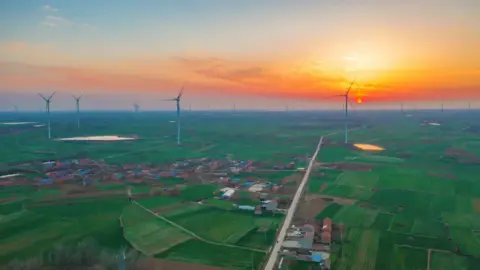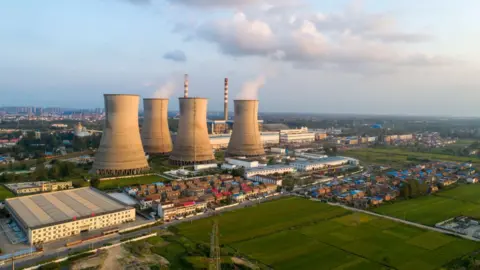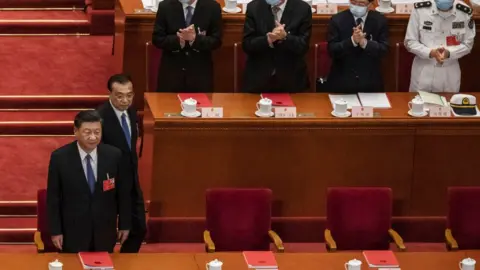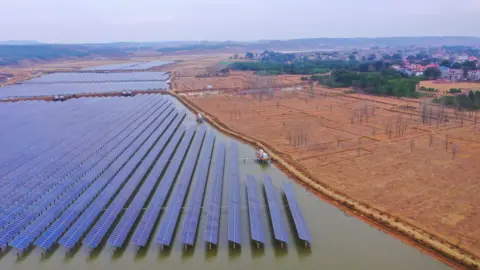Climate change: Will China take a 'great leap' to a greener economy?
 Getty Images
Getty ImagesTackling climate change may emerge as a key goal for China when it unveils its future economic roadmap in Beijing on Friday.
The 14th five-year plan will be the blueprint for the country's short-term development.
It's expected to outline stronger steps in limiting carbon from the world's biggest emitter.
But concerns over the impact on the economy could stem the shift towards greener policies.
What is the five-year plan?
Every five years since 1953, China has produced a planning document that sets out the government's targets for economic growth, social development and foreign policy over the next half decade.
Essentially, it is the political programme of the Chinese Communist Party and the plans are the framework that guide all policy decisions across government and industry.
For decades, they have sparked the fossil-fuel based growth of the Chinese economy, leading to rapid growth in GDP (gross domestic product) and rising living standards.
Why does it matter?
The key question for the Chinese government is: can it keep the economy growing while limiting the warming gases that threaten the entire planet.
Last September, Chinese president Xi Jinping surprised the world by announcing that the country would reach net zero emissions by 2060 and would peak their carbon use before 2030.
Net zero refers to cutting greenhouse gas emissions as far as possible and balancing any further releases by removing an equivalent amount from the atmosphere.
 Getty Images
Getty ImagesThis new five-year plan will be a critical step forward on that road, and will give analysts a good indication as to how realistic those aims are.
As well as outlining the steps for the next half decade, China is also looking longer term, sharing a series of objectives to 2035.
"What you see is China trying to identify the technologies of the future," said Isobel Hilton, founder and senior advisor to China Dialogue.
"These are low-carbon technologies, they are trying to move the economy up market, and to lay the foundations for China to become the supplier of low-carbon goods and technologies for a carbon constrained world."
What will be in the new plan?
There will be a handful of key targets that analysts will use to judge the scale of ambition in the plan.
Chief among them will be the numbers for economy-wide growth, but also for how much carbon is used per unit of GDP.
There will also likely be targets for non-fossil fuel in the overall amount of energy consumed.
 Getty Images
Getty ImagesAs important as the actual numbers will be the signals the plan sends to regional governments and industry.
"The key for the coming five years is to lay the groundwork by getting coal-dependent provinces and state-owned enterprises to diversify their economies and businesses and to stop investments in new fossil capacity," said Lauri Myllyvirta, lead analyst with the Centre for Research on Energy and Clean Air.
"The other prerequisite is to set sufficiently ambitious targets for clean energy so that the sector can grow to the scale needed towards the end of the decade."
Peak emissions
China has promised that emissions will peak "before 2030" (marking the point at which greenhouse gas releases slowly begin to decline). But some experts believe the new five-year plan could see the country aim to reach that peak a bit earlier.
However, this goal is not likely to make it into the document.
Traditionally, China likes to under promise and over deliver on climate issues.
 ALEX PLAVEVSKI
ALEX PLAVEVSKI"The likely targets for the share of non-fossil energy and for total energy consumption would leave space for emissions to increase almost 1% per year," said Lauri Myllyvirta.
"However, if the targets for clean energy are ambitious and overall energy demand growth proves to be slower than expected, it's entirely possible that emissions peak before 2025."
Others are more bullish.
"Based on our analysis, China will be able to peak emissions by 2025," said Li Shuo from Greenpeace East Asia.
"In our view, there is still a great potential for China to further enhance the peaking timeline from before 2030 to before 2025. And I think this is a view shared by most of the ministry analysis here in China."
If that was to happen, it would be a major boost to efforts to keep global temperature rise well under 2C this century. The goals of 2C and 1.5C have long been regarded as gateways to "dangerous" levels of warming.
The role of coal
The future consumption of coal in China is a critical issue for the world.
The country uses around half of all the coal that's produced worldwide every year.
In 2020, it opened three quarters of the world's newly-funded coal-fired power stations.
So while the senior leaders in the central government want the country to move away from coal, the reality on the ground is that more coal-fired capacity is being built by regional governments keen to deliver jobs.
"It seems that the resolve to end the construction of new coal power plants isn't there," said Lauri Myllyvirta.
"So the most likely outcome is continued additions of new coal power plants but zero or negative growth in generation - meaning mounting overcapacity."
How has Covid affected things?
Figures released this week showed that China rebounded rapidly from the economic slowdown associated with Covid-19, and finished the year with a larger tally of emissions than in 2019.
"In 2020, the production of some of the key industrial outputs, such as steel, cement and aluminium, went beyond the level of 2019. And that is quite astonishing," said Li Shuo.
"The Chinese economic recovery from the pandemic so far has been anything but green, so the upcoming five-year plan will therefore be a key text on how the country reconciles the old and the new."
 Getty Images
Getty ImagesOthers believe the shift to greener policies might now be slower than previously thought.
"China might set some compulsory energy/carbon intensity targets, but they are very likely still lower than the degree of GDP growth," said Zhang Shuwei, from the Draworld Energy Research Centre.
"I think it is possible that policymakers will set less ambitious targets on energy and coal consumption due to concerns about energy security," he said, speaking to Reuters.
Follow Matt on Twitter..
